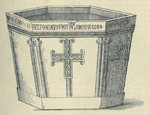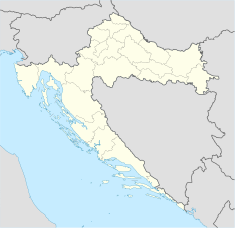
Zagreb is the capital and largest city of Croatia. It is in the north of the country, along the Sava river, at the southern slopes of the Medvednica mountain. Zagreb stands near the international border between Croatia and Slovenia at an elevation of approximately 158 m (518 ft) above sea level. At the 2021 census, the city itself had a population of 767,131, while the population of Zagreb urban agglomeration is slightly above one million people.

Aloysius Viktor Stepinac was a high-ranking Yugoslav Croat prelate of the Catholic Church. Made a cardinal in 1953, Stepinac served as Archbishop of Zagreb from 1937 until his death, a period which included the fascist rule of the genocidal Ustaše regime with the support of the Axis powers from 1941 to 1945 during World War II.

The Sacred Heart Cathedral is a Catholic church in Sarajevo; commonly referred as the Sarajevo Cathedral, it is the largest cathedral in Bosnia and Herzegovina. It is the seat of the Archbishop of Vrhbosna, currently Tomo Vukšić, and center of Catholic worship in the city. The cathedral is located in the city's Old Town district.

The Catholic Church in Croatia is part of the worldwide Catholic Church that is under the spiritual leadership of the Pope. The Latin Church in Croatia is administered by the Croatian Bishops' Conference centered in Zagreb, and it comprises five archdioceses, 13 dioceses and one military ordinariate. Dražen Kutleša is the Archbishop of Zagreb.

Franjo Kuharić was a Croatian Catholic cardinal, who served as the Archbishop of Zagreb from 1970 until his resignation in 1997. The cardinal was often referred to as the "Rock of Croatia" known for his defense of human rights and his urgings of peace and forgiveness during the independence conflict and the Bosnian War.

Kaptol is a part of Zagreb, Croatia in the Upper Town and it is the seat of the Roman Catholic archbishop of Zagreb. Due to its historical associations, in Croatian "Kaptol" is also used as a metonym for the leadership of the Roman Catholic Church in Croatia.

The history of Zagreb, the capital and largest city of Croatia, dates back to the Middle Ages. The Romans had built a settlement, Andautonia, in present-day Ščitarjevo. The name "Zagreb" was first used in 1094 at the founding of the Zagreb diocese in Kaptol, after the Slavs had arrived in the area. Zagreb became a free royal city in 1242. It was made the capital of Croatia in 1845 and elected its first mayor, Janko Kamauf, in 1851. According to the 2011 Croatian census, Zagreb had 792,875 inhabitants and was also Croatia's largest city by area.

The Assumption Cathedral is a Roman Catholic cathedral in Dubrovnik, Croatia. It is the seat of the Diocese of Dubrovnik.
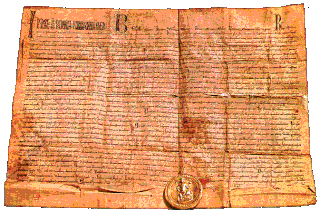
The Golden Bull of 1242 was a golden bull or edict, issued by King Béla IV of Hungary to the inhabitants of Gradec during the Mongol invasion of Europe. By this golden bull, King Béla IV proclaimed Gradec a royal free city. The document was issued on 16 November 1242 in Virovitica and reaffirmed in 1266. The original is written on a piece of parchment 57 by 46 centimetres in size, and is kept in strictly controlled conditions in the Croatian State Archives in Zagreb, while a copy is exhibited in the Zagreb City Museum.

The Church of St. Mark is the parish church of old Zagreb, Croatia, located in St. Mark's Square. It is one of the oldest architectural monuments in Zagreb.
The following is a timeline of the history of the city of Zagreb, Croatia.
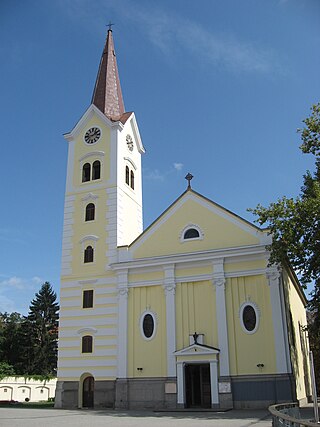
Cathedral of Exaltation of the Holy Cross is a cathedral in the Diocese of Sisak. It is located in the center of Sisak on Ban Jelačić Square.

Cathedral of Teresa of Ávila in Bjelovar is the baroque church of Diocese of Bjelovar-Križevci. It is located in the center of the town of Bjelovar, Croatia, on Eugen Kvaternik Square. Until 2009, when it became a cathedral, it was parish church.

The Kaptol manors form a series of 25 manors along the Kaptol Street in Zagreb, Croatia that were used to house canons and other officials of the Archdiocese of Zagreb. The manors were built at various times between the Middle Ages and the 19th century. Most of those preserved date from the Baroque period, while those in the best condition are mostly from the 19th century. The manors were designed as large town houses surrounded by gardens. Each has its own history and peculiarities. The most important are those which were inhabited by prominent canons.

Josip Mihalović was a Croatian-Hungarian Cardinal of the Catholic Church and Archbishop of Zagreb from 1870 to 1891.

Croatia–Holy See relations refer to the bilateral relationship between Croatia and the Holy See. Diplomatic relations among the two countries were established on February 8, 1992, following Croatia's independence from SFR Yugoslavia, although they date far back in history.

Novi Dvori of Zaprešić, or Novi Dvori of Jelačić, is a feudal estate in the northwestern part of Zaprešić, Croatia. The estate consists of a castle, an old granary renovated into a museum, a circular threshing machine, a neo-gothic chapel and the Jelačić family tomb.

The Basilica of the Heart of Jesus is a Roman Catholic basilica located in Palmotićeva street of Zagreb, Croatia. It is dedicated to the Sacred Heart, and was designed by the Croatian architect Janko Holjac in the neo-Baroque style.
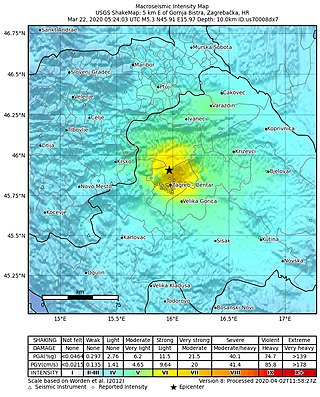
At approximately 6:24 AM CET on the morning of 22 March 2020, an earthquake of magnitude 5.3 , 5.5 , hit Zagreb, Croatia, with an epicenter 7 kilometres (4.3 mi) north of the city centre. The maximum felt intensity was VII–VIII on the Medvedev–Sponheuer–Karnik scale. The earthquake was followed by numerous aftershocks, the strongest of which with a magnitude of 5.0. It was the strongest earthquake in Zagreb since the 1880 earthquake and caused substantial damage in the historical city center. More than 1,900 buildings were reported to have been damaged to the point of becoming uninhabitable. The earthquake was also felt in Slovenia. One person was killed and 27 others were injured.

Cathedral of St. James Senior was a mediaval Roman Catholic church in what was once Krbava. It was consecrated to St. James, the patron saint of former Diocese of Krbava. The information about consecration of Krbava Cathedral to St. James Senior was found by bishop Mile Bogović, while searching the Vatican Archives in 1997.

